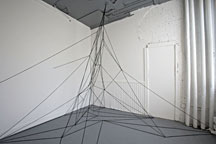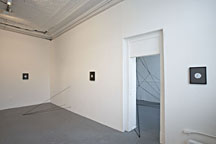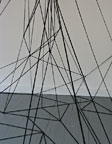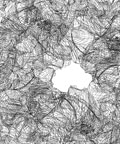Articles on Indian contemporary art by Swapna Vora

by Swapna Vora
September 07, 2007
(click
on the small image for full screen image with captions.)
Then, her prints too look like delicate hand drawn lines but are actually computer generated, using several software programs and could extend into infinity. A growing pattern of galactic lines, and delicate, digital drawings reflect on the nearby wool crystal installation. These tiny circles are doorways into a world of lines beyond, they are perhaps the portals of outer space, the entry into tiny worlds, or perhaps just glimpses into microscopes. One sees other worlds made of lines, there are hints of space fiction, new galaxies and our ultimate mystery: the delicate tracery of human thought.
All
media is a collective sound, movement and graphics. Prema wanted to pare
down and go into a minimal space as asked whatever had to be said, could
it be said with less? She finally focused simply on the least: just form
and line and thought about networks and electronic nets. She is interested
in identity, the nature of what makes me 'me' and not someone else, how
something is itself. These pictures are an exterior show of our inner
identity, showing the networks of our lives, perhaps also the spider's
web of creation that the earth's aborigines sometimes discuss. And so
she says, we are networked, our thoughts are outside of ourselves, our
physical self.
What does she dream of? Constant change, she replies. This computer child
has pull-down menus, websites and electronics in her dreams. She says
she started with design work and advertising to make money and then did
her own explorations. Today, given space by delighted art directors and
curators in many museums and galleries, she makes these prints and installations:
sometimes ephemeral, often with simple material.
Prema has offered some comments in her internet exhibits on pornography: no vociferous denunciation but rather a subtle observation of slavery. This mostly male desired phenomena, is often a shady, shifty work of abuse, where torture parades as erotica. True erotica, delicious, naughty, playful, secret is alas all too rare. Meanwhile slavery is passed off as erotic and Prema speaks on pornography, a word which means the depiction of slaves, the bonded laborer, the unfree. (Porno: slave, graph: depiction). Everyone loves erotica but pornography is a mean depiction of someone's power over someone else, a victim is always involved. A victim who is usually weak, without clothes or protection and is abused and beaten for the 'entertainment' it gives someone else. Pornography then is a comment on unkindness and distress and since this is always intermingled by its directors with images of beautiful, often unbelievably beautiful, people, the mind can get confused. Prema refers to this in her website. She refers too to everyone's fascination with bindi, that colorful dot that Hindu women and others, sometimes even men, sport on their foreheads.
She informs me that she is American by birth, has spent a year in her parents' Indian homeland and has learned the art of kalaripattu , the ancient south Indian art of self-defense specifically designed for women. She is a pretty, gleaming woman and reflects her years devoted to physical exercise and yoga alongside her ventures into creativity.
PS 1, a branch of New York's
MOMA offered Prema space for an installation made specifically for its
rooms and the curators were pleased with her technological approach while
using low tech material. Prema uses black and white, a lack of color.
For her, black is not simple and we spoke of the seven essential shades
of black, often seen very clearly in Chinese paintings. Her work intertwines
science fiction, cosmology and infinity and evokes something simple, like
a cat playing with wool, with everyday black yarn.
The broken ceiling, the uneven floors, the stark bricks of PS 1 make one
smile. The curator explained that an earlier artist had dug up the floor
before they could explain to him that, if they had known, they would have
given him a different sort of floor. Anyway, she added, everyone seems
to like this uneven simple floor, the slightly rough ceiling and some
visitors even like the 'schoolish' appearance of this erstwhile school.
| Biography: Prema
Murthy was born in 1969. |






